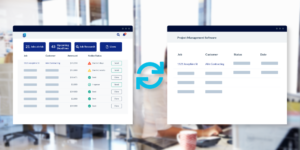
If you’re reading this blog post, you’re probably well aware that nothing in the construction industry is simple. With so many moving parts and people involved, many contractors lean on different software services to keep it all straight. One of the most common and comprehensive of which is an ERP, aka Enterprise Resource Planning.
What is ERP software?
An ERP is a software that helps automate business processes spanning across multiple departments like accounting, sales, human resources, and other important functions. Beyond helping with the day-to-day management of operations, an ERP is a centralized location for a ton of data, allowing that data to provide valuable insights for business leaders about what’s going well and what needs improvement.
If you’re not using an ERP system currently, it might be worth looking into! Here’s a helpful article that dives a little deeper into the whats and whys of ERPs.
How does ERP software work with lien rights software?
So what do additional construction payment tools have to do with ERPs? Good question! The construction payment process is complicated and nuanced, and cloud-based software can make this process easier and more efficient. These systems can also often be plugged into the ERP system so the two can work flawlessly together towards the great goal of getting paid and expanding business.
For example, Levelset is a leading lien rights software platform that works to help contractors manage their lien rights with a range of different features and services to empower people to always get what they earn. We have seen firsthand what a huge difference software can make in protecting and expanding business, especially when strategically combined with other industry software.
Levelset directly integrates with various ERP systems to automate the flow of data between the two, and it is a real game-changer for those in charge of the day-to-day management. Specifically, because you’re spending less time on data entry and protecting lien rights in general, and it leads to higher accuracy on their notices and in their job information stored internally.
We’ve seen this integration work time and time again. However, for those who haven’t used lien rights software or other payment tools, they are often concerned that implementing a new ERP in the business is too daunting of a task to also consider adding additional software into the mix.
We get it! ERP switches can feel like a lot. Maybe your data wasn’t so clean in the previous software you were using. Maybe you weren’t using any software at all. Or maybe, you were using too many software platforms and your data is a bit scattered. No matter the specific issue, missing key pieces of information often surface while transitioning ERPs.
Additionally, the process of switching over to a new system, coming up with a better plan to manage all this data, and getting everyone on board can be time-intensive and mentally draining.
However, implementing a new ERP system is a great time to also implement software to help with construction payments.
Why is implementing a new ERP system a good time to implement lien rights software?
Consider this: When you implement software like Levelset, you are going to need some of your job information handy to get started protecting jobs, as well as a desired process for transferring that data from one system to another smoothly and on a consistent basis. It doesn’t have to be perfect, but we certainly will need to know the basics!
As you are learning what key pieces of information are needed for Levelset to begin or continue protecting your lien rights, it will become crystal clear if you have gaps in job information stored in your current ERP. It’s better to analyze and problem solve the two implementation needs side by side rather than waiting months to tackle one as you focus on the other. It could create double the work.
ERP implementation also generally takes a fair bit of technical lift. You wouldn’t want your tech team to work for months on this ERP transition to then have to call them back to work on another software integration right when the ERP is off the ground, and in the process, maybe change some of the things they just spent months ironing out. It will be smoother for everyone involved if the two implementations are almost treated as one. As you iron out where data is held in the new ERP and then what data is needed in a system like Levelset, you can use the two to complement each other — maybe even building a direct integration between the two so they can feed data back and forth.
And we can’t forget about one of the most important parts of implementing any new software — training your team!
Not only do your teams have a lot on their plates, but they might also be very comfortable with their current processes, and potentially resistant to change. If the ERP and lien rights system are intertwined, then you’ll be able to train your team on the all-encompassing new day-to-day system. Adding the job into the ERP for accounting purposes, for example, and then checking off a box that says “send to Levelset” so we can automatically research the missing job details and take care of the required preliminary notices.
And there you go — one streamlined process that includes two softwares, working together smoothly and efficiently to keep your business humming and growing.
What is the Takeaway?
TL;DR: ERPs are great, and so is software that helps automate construction payments and manage your lien rights. Both are going to take some time and work to implement, but the work is well worth it and there is no need to put one off for the other. In fact, it’s better for everyone involved to knock out the setup and implementation of both, together.
Talk to someone on the Levelset team today to learn how you can get started with Levelset while working with a new ERP.

Want to see how it works?
A payment expert on our team is ready to walk you through what it looks like to manage your lien rights paperwork using software.
